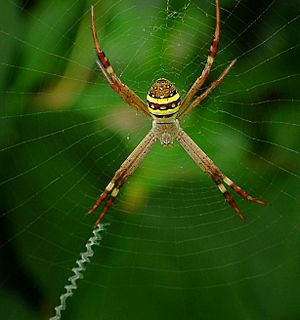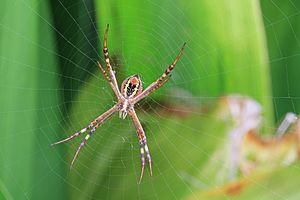St Andrew's cross spider facts for kids
Quick facts for kids St Andrew's cross spider |
|
|---|---|
 |
|
| Young female Argiope keyserlingi from Brisbane | |
| Scientific classification | |
| Genus: |
Argiope
|
| Species: |
keyserlingi
|
The Argiope keyserlingi is a type of orb-web spider found along the east coast of Australia. You can find it from central New South Wales up to northern Queensland. This spider looks very much like its close relative, Argiope aetherea, which lives in North Queensland.
You often see A. keyserlingi in large groups in parks and gardens, especially among the leaves of the Lomandra longifolia plant. Like many orb-web spiders, the female A. keyserlingi is much bigger than the male. This is called sexual size dimorphism. You can spot adult females during the summer months. It's common to see several small males on one female's web!
A. keyserlingi is usually called the St. Andrew's cross spider. This name comes from the special silk patterns it builds on its web. These patterns look like an X-shaped cross, similar to the cross where St. Andrew is said to have been crucified. Young spiders sometimes make a spiral pattern instead. These silk patterns are called web decorations or stabilimenta. Scientists think these decorations might help the spider catch more prey. In other spider species, these decorations can also protect the spider from animals that want to eat it.
Scientists often study A. keyserlingi to learn about spider ecology (how they interact with their environment) and behaviour. They have used this spider to study how spiders choose their mates, how male and female sizes differ, and why spiders make web decorations.
In Sydney, the main animals that eat these spiders are mantids and birds. This type of orb-weaver spider is cathemeral, meaning it is active during both day and night.
Contents
About the St. Andrew's Cross Spider
The spider was named by Fredrich Karsch in 1878. He named the first part, Argiope, after a mythological Greek character, a nymph from the town Eleusis. The second part of the name, keyserlingi, was chosen to honor a spider expert named Eugen von Keyserling.
What Does It Look Like?
Female St. Andrew's cross spiders are usually between 10 mm and 16 mm long. Their bodies are shiny and have silver, yellow, red, and black stripes on the top part. They also have two yellow bands underneath.
Male spiders are much smaller, usually only 3 mm to 4 mm long. They are brown and have a pearly color. These spiders often rest with their legs held in pairs, making them look like an X.
Where Do They Live?
You can find the St. Andrew's cross spider mostly in the edges of rainforests, open forests, and heathlands in eastern Australia. They also live in the northern part of the Northern Territory, the northern part of Tasmania, and the western part of Western Australia. You can even find them near the Ok Tedi River in Papua New Guinea, on the Malakula island in Vanuatu, all over Lord Howe Island, and near the Shihe-Shiguan River in China.
St. Andrew's cross spiders build medium-sized webs on low vegetation like shrubs.
Their Amazing Webs
The web of the St. Andrew's cross spider has wavy, bluish-white ribbons made of silk. These ribbons can form a full cross or a partial cross (like an X) in the middle of the web. This cross-like pattern is called a stabilimentum.
Scientists have wondered for a long time why spiders make these decorations. At first, they thought the stabilimentum made the web stronger. Other ideas suggest it helps catch prey or helps the spider hide from predators. The exact reason is still a bit of a mystery!
One interesting thing about the stabilimentum is that it reflects ultraviolet light. This makes it very attractive to flying insects, which might help the spider catch more food. However, this design also makes the web and the spider easy for daytime predators, like birds and wasps, to see.
The shape of the cross-like decoration can change. It can be a complete cross, a partial cross with 1-3 arms, or sometimes no decoration at all. This changing shape might make it harder for predators to recognize the web. Scientists also think the stabilimentum might be a warning sign to tell predators to stay away.
What Do They Eat?
The St. Andrew's cross spider eats different kinds of insects that get caught in its web. Their prey includes:
Once an insect is caught, the spider quickly wraps it neatly in silk before it starts to digest it. Smaller prey might be eaten right away.
Reproduction and Life Cycle
Mating for these spiders happens from summer to autumn. It can be a risky time for the tiny male St. Andrew's cross spiders. One or more males will settle on the upper part of a female's web. Some males might even be missing legs, perhaps from earlier encounters with females who weren't ready to mate.
The male then creates a special mating thread within the web. He attracts the female by gently shaking this thread. After mating, the female hangs her pear-shaped egg sac in a net of silk threads. She often surrounds it with leaves to camouflage the sac's greenish silk. However, these egg sacs can still be targeted by wasps and flies.
See also
 In Spanish: Argiope keyserlingi para niños
In Spanish: Argiope keyserlingi para niños


